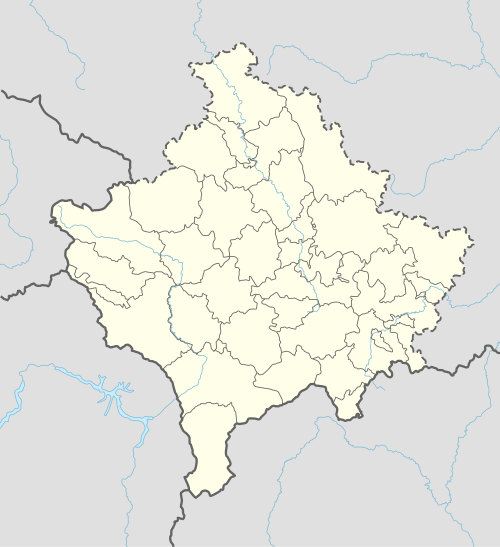Grnčar, Klokot
Grnčar (Serbian Cyrillic: Грнчар, Albanian: Gërncar), formerly Grnčare (Грнчаре, until 1975), is a village in the Klokot municipality, in southeastern Kosovo. It was formerly part of the Vitina municipality, then was together with Klokot and Vrbovac formed as part the Klokot municipality on 8 January 2010, based on the Ahtisaari plan. The village, and municipality, is a Kosovo Serb enclave. It has 240 inhabitants (2011 census). It is located in the geographical region of Gornja Morava, and is situated 583 m above sea level.
Gërnçar Grnčar | |
|---|---|
Village | |
 Gërnçar Location in Kosovo | |
| Coordinates: | |
| Location | |
| District | Gjilan |
| Municipality | Kllokot |
| Population (2011)[1] | |
| • Total | 240 |
| Time zone | UTC+1 (CET) |
| • Summer (DST) | UTC+2 (CEST) |
The village has a medieval church, dedicated to St. Nicholas. It was mined and destroyed by Albanians during the Kosovo War. There are archaeological sites located within the cadastral area. A palaeolithic cave is located below the St. Nicholas Church.[2] Remains of a Roman-era stone building are located 2,5 km from the village, on the left side of the Grnčar–Letnica road.[3] The locality of Gradište has remains of Roman, Byzantine and medieval fortification (2nd–14th c.).[4]
| Census | 1948 | 1953 | 1961 | 1971 | 1981 | 1991 | 2011 |
|---|---|---|---|---|---|---|---|
| Total | 374 | 447 | 456 | 516 | 523 | 477 | 240 |
Anthropology
According to the studies of A. Urošević, published in 1929, the village was inhabited by eight families in 31 houses; six Serb, one Albanian, and one Romani:[5]
- Irinići (5 houses, slava of St. Nicholas), Serbs, natives.
- Krčmarovići (8 h., St. Nicholas), Serbs, natives.
- Brankovići (4 h., St. Nicholas), Serbs, natives.
- Niševci (6 h., St. Nicholas), Serbs, very old settlers from the Niš area, hence their surname.
- Pejići (4 h., St. Nicholas), Serbs, moved from Žegra around 1850.
- Rustemovići (2 h.), belong to the Gashi fis (clan). Settled in 1878 as muhajirs from the Leskovac area.
- Hsini (1 h.) and Asanović (1 h.), Muslim Romani, moved, as labourers and blacksmiths, between many villages of Gornja Morava.
Notes
- Kosovo is the subject of a territorial dispute between the Republic of Kosovo and the Republic of Serbia. The Republic of Kosovo unilaterally declared independence on 17 February 2008, but Serbia continues to claim it as part of its own sovereign territory. The two governments began to normalise relations in 2013, as part of the 2013 Brussels Agreement. Kosovo is currently recognized as an independent state by 97 out of the 193 United Nations member states. In total, 112 UN member states recognized Kosovo at some point, of which 15 later withdrew their recognition.
References
Sources
- Урошевић, A. (1929). Горња Морава и Изморник. СЕЗб.CS1 maint: ref=harv (link)
- Kalezić, Dimitrije M. (2002). A - Z. Savremena administracija. p. 493.